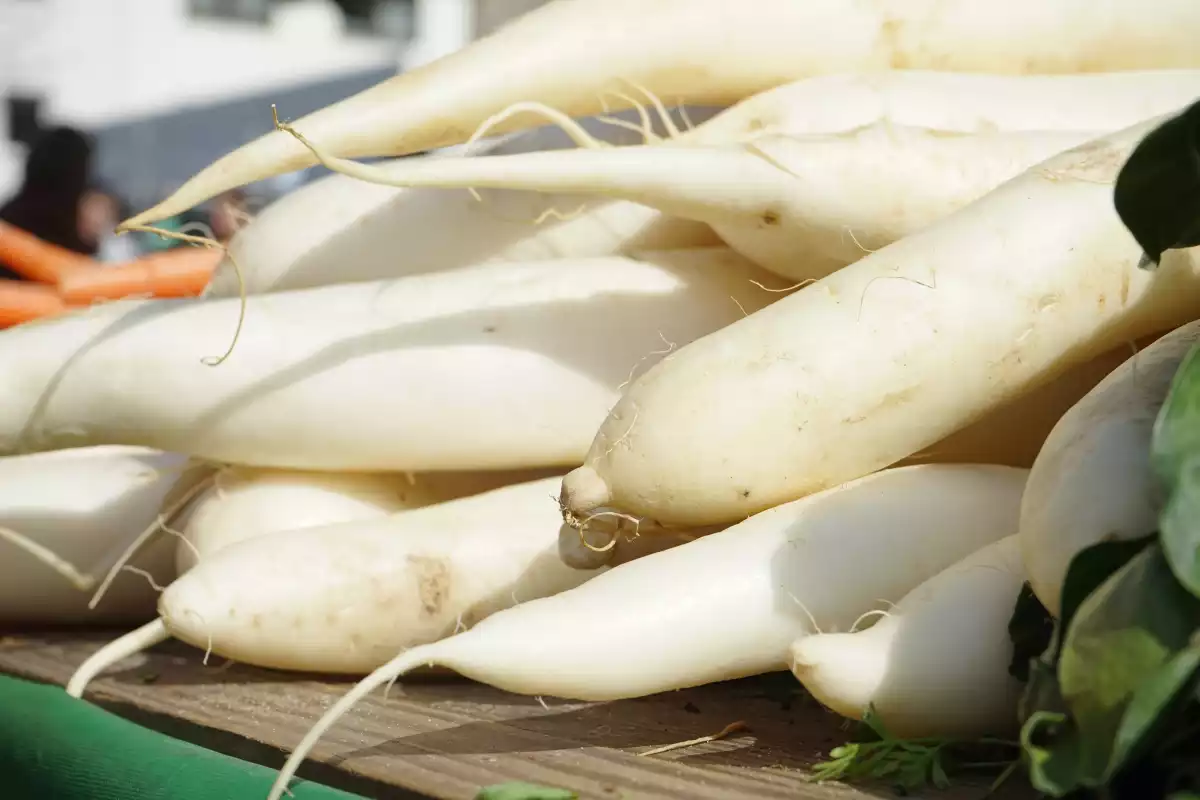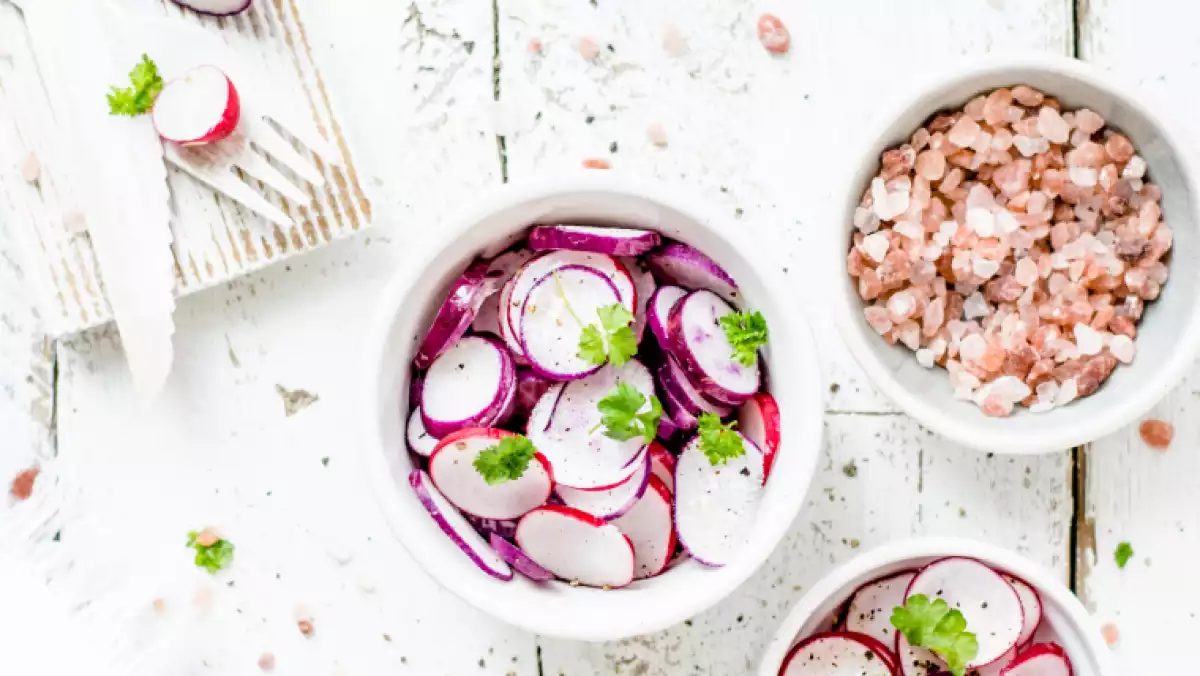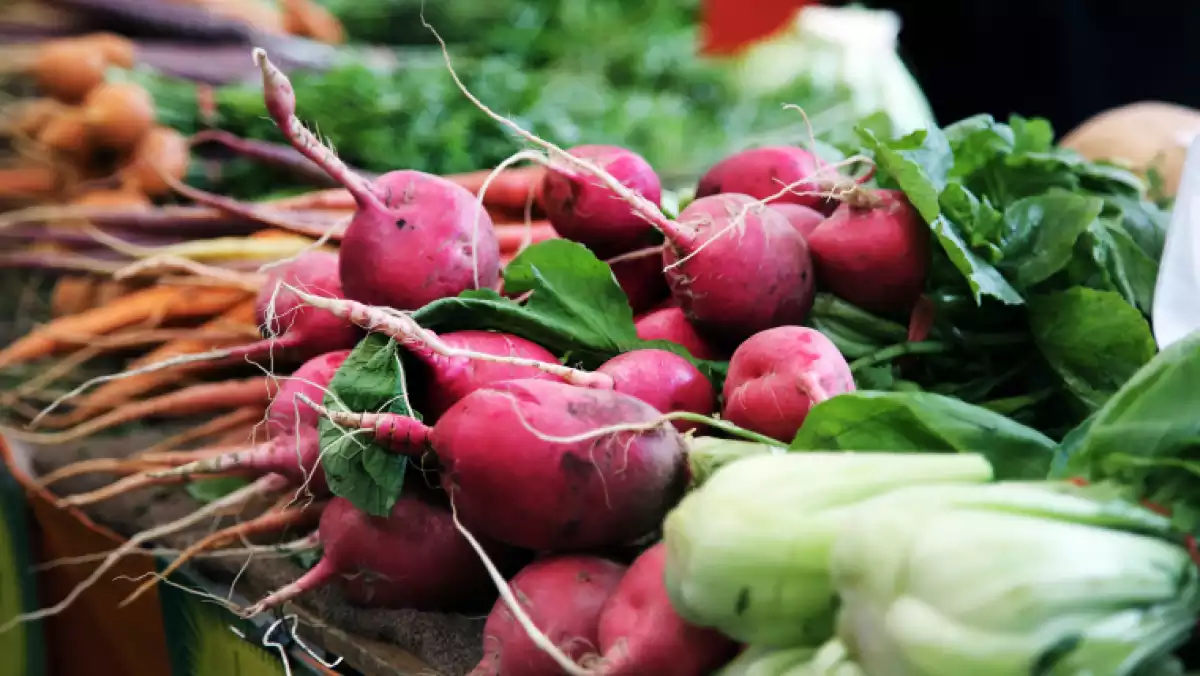The radish is an edible root vegetable originally from China that is grown due to its intense flavor and medicinal properties. Currently, there are different types of radishes being cultivated such as horseradish and black radish, as some of the main types. We aim to examine the history of radishes, their uses and health benefits as well as the main types. Finally, we will list a few simple radish recipes that you can enjoy anytime.
History and definition
The scientific name of this root vegetable is Raphanus raphanistrum subsp. sativus, and it belongs to the Brassicaceae family of plants from the genus Raphanus. The main features of radishes are their edible swollen tap roots which can be globular, tapering, or cylindrical, and their specific, potent aroma and taste. Radishes have white, or lilac flowers and its fruits are small pods which can be eaten when young.
The most accepted theory is that radishes were initially cultivated in China and were subsequently imported to areas such as Egypt, Greece, and Rome - one ancient story talks about the Egyptians that built the pyramids and how they used to eat radishes daily to stay healthy and energetic. Nowadays, they are cultivated successfully all over the globe.
Aside from their culinary uses, radishes have been grown for their different medicinal properties as well as their health benefits. The many species of radishes have now taken over international harvests, yielding crops of black radish, horseradish, and Daikon long white radish.
Health benefits of radishes and properties
Radishes contain significant amounts of vitamin C and other vitamins and minerals and a few phytochemicals such as indoles. They also contain an essential isothiocyanate antioxidant compound called sulforaphane, a potential cancer fighter. Moreover, they remove bilirubin from the liver, preventing jaundice, and perform other helpful tasks such as purifying the kidneys, regulating blood pressure, and boosting immunity.
Due to these properties, radishes have different benefits such as increasing the immune system, effects as antioxidants and have antimicrobial properties. Traditional medicine also includes the root in treatments for gallbladder ailments, liver failure, arthritis, and scurvy - due to its high content of vitamin C. Moreover, benefits include purifying and diuretic effects especially when taken in juice form on an empty stomach, or when the dry leaves are infused.
As a cure for the common cold, radishes can be mixed with honey while for burns the best remedy is to combine radishes and ice. Finally, because of its powerful odor, the roots of the radish plant have been used as a deodorant. To liven up a salad and get some healthful benefits at the same time, buy a bunch of radishes and slice them thinly in your next tossed salad. Deliciously tangy!

Types of radishes
The radish plant has been cultivated for its edible root and medicinal properties. This traditional plant comes in many different forms from black radishes to gargantuan ones - like the Sakurajima radish, and each type is more surprising than the other.
1. Cherry belle red radish
Cherry belle red radishes or simply red radishes are the small, red radishes we all know and love. This common variety of radish is often found in your local supermarket, and it is delicious in salads. Red radishes are packed with Vitamins E, A, C, B6, and K. They are also extremely high in antioxidants, fiber, zinc, potassium, phosphorous, magnesium, copper, calcium, iron, and manganese.
2. Black radish
Also called Spanish black radish, this variety of Rapahnus sativus is marked by black exterior color, with a more challenging to digest skin, while the inside of the root remains white. The black radish has become famous due to its therapeutic properties which include digestive effects, antiseptic and expectorant properties.
One study reported that in comparison with other cruciferous vegetables, Spanish black radishes contain four times more glucosinolates, believed to enhance detoxification. Clinical tests showed them to have a greater ability to detoxify enzymes, metabolize faster and quickly reduce DMBA-induced bone marrow toxicity. Scientists concluded that the findings support the hypothesis that glucosinolates in Spanish black radishes are protective against acute toxicity.
3. Horseradish
Horseradish is a root vegetable used as a spice and prepared in many countries as a condiment. The plant is native to southeastern Europe and western Asia, but it is famous worldwide. It grows up to 1.5 meters tall and is cultivated primarily for its large, white, tapered root. It is used to prepare a condiment similar to mustard or to substitute wasabi, although it is also famous for its aromatic properties and digestive effects.
4. Daikon long white radish
The Japanese radish also known as the Daikon long white radish is a mild-flavored winter radish usually characterized by fast-growing leaves and a long, white, napiform root. The name comes from its Japanese origin where it is used in dishes such as miso soup or wasabi paste.
5. French breakfast radish
French Breakfast radish can be round in root shape but most are oblong and five to ten cm in length. Whether round or cylindrical, the French Breakfast radish is known for its vibrant color which gradually fades from a bright fuchsia-red to bright white at the tip. Topped with edible, leafy greens, French Breakfast radishes are very crisp and offer a mildly spicy flavor. Grilling or oven roasting will bring out the subtly sweet and nutty flavor of this delicious type of radish.
6. Korean radish
Mu or Korean radish is a variety of white radish with a firm, crunchy texture. Although mu is also a generic term for radishes in Korean, the word is usually used in its narrow sense, referring to the Joseon radish. Famous recipes that include this ingredient are seasoned radish strip salad, red radish and carrot salad, and white radish kimchi.

Radish recipes
Radishes are a trendy ingredient in different cuisines around the world. Due to the potent flavor, these vegetable roots are also used as spices or incorporated into dressing sauces. Another delicious way of eating this root is pickled radishes - a fantastic addition to stews and soups, that enhances the flavors of meat and other vegetables.
The Raphanus raphanistrum subsp. sativus is used in many Japanese dishes such as sushi and miso soup, although you can find variations of these meals without the root. Another example of radish recipes would be the famous Mexican pozole, a broth of boiled hominy with pork meat that uses fresh radishes as the final ingredient. Radishes are easy-to-use vegetable roots that can also be used as spices in almost any salad due to their freshness and slight spicey aroma.
Quinoa and broccoli radish salad
A fresh and healthy radish salad, this quinoa and broccoli mix is jam-packed with nutrients such as carbohydrates like dietary fiber, vitamins A, B, and C as well as minerals like iodine, dietary fiber, and calcium among others. This easy-to-make recipe serves four people, and you will need the following ingredients:
- 250 g quinoa
- 1 medium broccoli
- 5 cherry belle radishes
- 25 g radish sprout
- 1 lemon
- 1 tbsp. mustard
- salt and pepper to taste
- olive oil to taste
First, boil the vegetables and quinoa in a large pot (save the radishes to add raw) and while they're cooking, prepare the dressing. In a separate bowl, mix the mustard, lemon juice, salt and pepper, and olive oil. Finally, mix all the ingredients and drizzle with more lemon juice if needed.
Chicken salad with radishes and apples
This chicken salad is far from boring or predictable, with a fresh mix of peppery radish, crunchy celery, and deliciously juicy apples. You will need the following ingredients for this simple radish recipe:
- Kosher salt and pepper
- 1 1/2 lb. boneless, skinless chicken breasts
- 1/4 c. low-fat sour cream
- 2 tbsp. mayonnaise
- 4 radishes
- 2 stalks celery
- 1 small green apple
- 2 scallions
- 1 bundle watercress
First, fill a medium saucepan halfway with water; bring to a boil and add 1 tsp of salt. Add the chicken, reduce heat and gently simmer until cooked through 10 to 12 minutes. Next, transfer the chicken to a plate. When cool enough to handle, shred or cut into pieces. Then, in a large bowl, whisk together the sour cream, mayonnaise and ½ tsp each salt and pepper. Add the chicken and toss to coat. Finally, add the radishes, watercress, celery, apple, and scallions and mix to combine.
Growing radishes
If you've ever wondered how to plant radishes, you're in luck because radishes are a fast-growing, annual, cool-season crop which means you can plant them every year. This leafy green has short and thick stalks and rough, dark green leaves. It is usually grown at altitudes of 1300 m, and the plant prefers fertile, well-drained, deep, sandy soils rich in organic matter for best growth.
How to grow radish in terrace garden
The best temperature is between 20 and 25ºC, and it can take up to 25 weeks to grow, depending on climate conditions. This root vegetable can also be grown at home, as long as it has plenty of space and good quality soil. The plant should be checked regularly - approximately three times every week, because its leaves are prone to insect pests, including cutworm, aphids, flea beetles and root maggots.
- This article about "Radish" was originally published in Spanish in Viviendo La Salud
References:
CECMED (2017). Resumen de las características del producto: Rábano yodado. Recuperado 07 de febrero de 2018. Available at https://www.cecmed.cu/sites/default/files/adjuntos/rcp/070-17d3_rabano_yodado.pdf
Fonnegra, R. y Jiménez, S.L. (2007). Plantas medicinales aprobadas en Colombia. Editorial Universidad de Antioquia: Colombia.
Martin, P. (2016) Cocina consciente no. 14. Comer sano, sentirse bien. Fox Andina Editorial: Argentina.
N'jai AU, Kemp MQ, Metzger BT, Hanlon PR, Robbins M, Czuyprynski C, Barnes DM. (2012) Spanish black radish (Raphanus sativus L. Var. niger) diet enhances clearance of DMBA and diminishes toxic effects on bone marrow progenitor cells.
